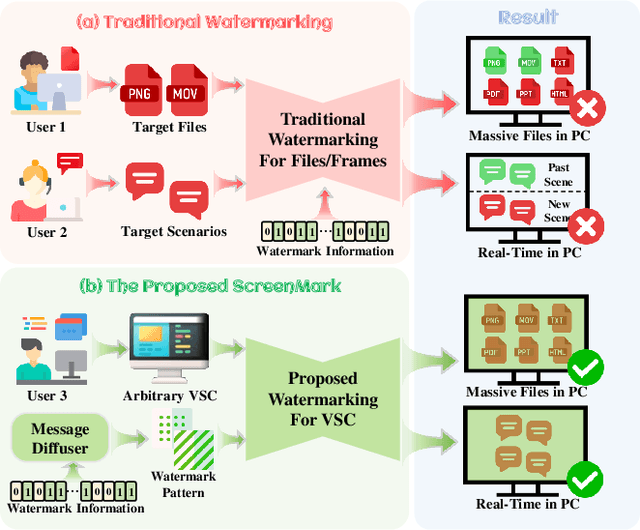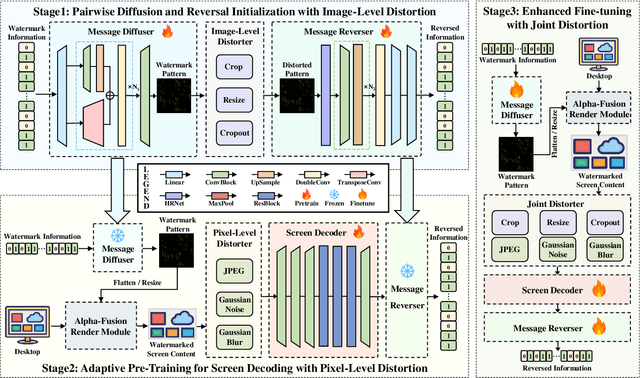Xiujian Liang
ScreenMark: Watermarking Arbitrary Visual Content on Screen
Sep 05, 2024



Abstract:Digital watermarking has demonstrated its effectiveness in protecting multimedia content. However, existing watermarking are predominantly tailored for specific media types, rendering them less effective for the protection of content displayed on computer screens, which is often multimodal and dynamic. Visual Screen Content (VSC), is particularly susceptible to theft and leakage via screenshots, a vulnerability that current watermarking methods fail to adequately address.To tackle these challenges, we propose ScreenMark, a robust and practical watermarking method designed specifically for arbitrary VSC protection. ScreenMark utilizes a three-stage progressive watermarking framework. Initially, inspired by diffusion principles, we initialize the mutual transformation between regular watermark information and irregular watermark patterns. Subsequently, these patterns are integrated with screen content using a pre-multiplication alpha blending technique, supported by a pre-trained screen decoder for accurate watermark retrieval. The progressively complex distorter enhances the robustness of the watermark in real-world screenshot scenarios. Finally, the model undergoes fine-tuning guided by a joint-level distorter to ensure optimal performance.To validate the effectiveness of ScreenMark, we compiled a dataset comprising 100,000 screenshots from various devices and resolutions. Extensive experiments across different datasets confirm the method's superior robustness, imperceptibility, and practical applicability.
StyleStegan: Leak-free Style Transfer Based on Feature Steganography
Jul 01, 2023



Abstract:In modern social networks, existing style transfer methods suffer from a serious content leakage issue, which hampers the ability to achieve serial and reversible stylization, thereby hindering the further propagation of stylized images in social networks. To address this problem, we propose a leak-free style transfer method based on feature steganography. Our method consists of two main components: a style transfer method that accomplishes artistic stylization on the original image and an image steganography method that embeds content feature secrets on the stylized image. The main contributions of our work are as follows: 1) We identify and explain the phenomenon of content leakage and its underlying causes, which arise from content inconsistencies between the original image and its subsequent stylized image. 2) We design a neural flow model for achieving loss-free and biased-free style transfer. 3) We introduce steganography to hide content feature information on the stylized image and control the subsequent usage rights. 4) We conduct comprehensive experimental validation using publicly available datasets MS-COCO and Wikiart. The results demonstrate that StyleStegan successfully mitigates the content leakage issue in serial and reversible style transfer tasks. The SSIM performance metrics for these tasks are 14.98% and 7.28% higher, respectively, compared to a suboptimal baseline model.
 Add to Chrome
Add to Chrome Add to Firefox
Add to Firefox Add to Edge
Add to Edge